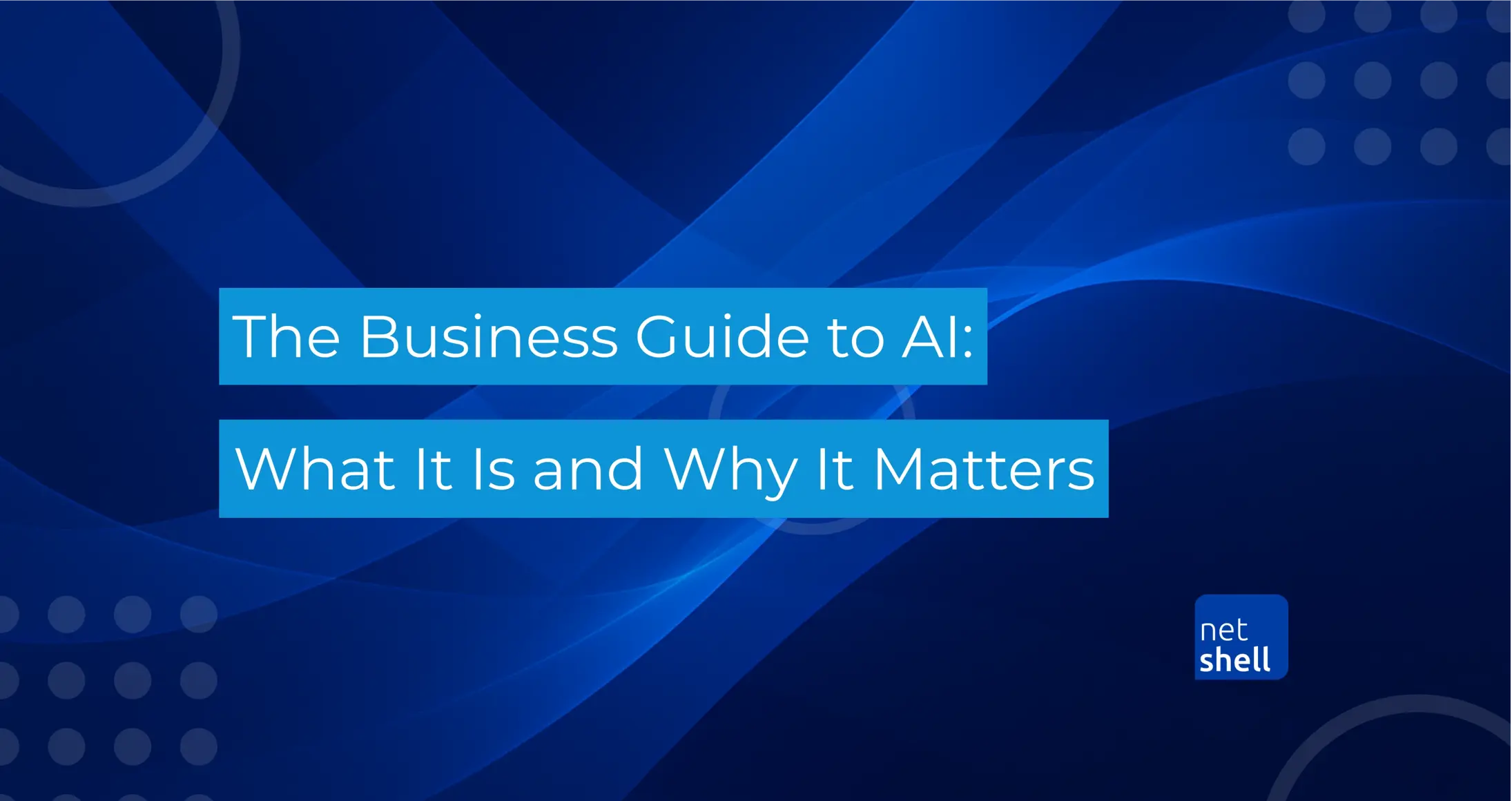Artificial intelligence is no longer a futuristic idea, it has become a key driver for innovation and efficiency for businesses across all industries. From automating routine tasks to providing insights that were previously unimaginable, AI is changing the way organisation operate.
Despite its growing influence, many businesses are still unsure of where to start with AI. Over 50% of companies plan to incorporate AI technologies into their operations[1], but questions remain around how to integrate it effectively and how to manage potential risks.
This guide is designed to provide a clear and practical overview of AI for business leaders. It will explain what AI is, the different types of AI technologies and the benefits they can bring. It will also uncover real-world use cases across industries and departments, insights into challenges to watch for as well as guidance on best practices for implementing AI responsibly.
By following this guide, you will gain a structured understanding of AI and the tools to make informed decisions about how it can be applied strategically in your organisation.
What is AI?
AI is the development of computer systems capable of performing tasks that typically require human intelligence. These tasks include recognising patterns, understanding language, making decisions and even learning from experience. Unlike traditional software, which follows explicit instructions, AI systems can analyse data, identify trends and adapt their behaviour over time. This allows them to tackle complex problems that would be time-consuming or difficult for humans to solve manually.
AI is not a single technology but a collection of approaches and methods. These include machine learning, where systems improve performance by learning from data; deep learning, which uses layers of neural networks to model complex patterns; natural language processing, which enables machines to understand and generate human language; and computer vision, which allows AI to interpret visual information from the world.
AI systems can be rule-based, relying on predefined instructions or they can be more advanced and autonomous, learning from vast amounts of data to make decisions and predictions. They are increasingly integrated into everyday business processes, from customer service chatbots to predictive analytics tools that help organisations make smarter, data-driven decisions.
Types of AI
AI can be categorised into several types based on its capabilities and applications. Understanding these distinctions helps businesses see where AI is today and what may be possible in the future. The main categories include
- Narrow AI: These systems are designed to perform a specific task extremely well, but they do not possess general intelligence. Common examples include virtual assistants like Siri or Alexa, recommendation engines used by retailers to suggest products and fraud detection systems in banking. Narrow AI is the most common form of AI is use today.
- General AI: This type of system would be capable of performing any intellectual task a human can do, with the ability to learn, reason and adapt across multiple areas. General AI remains largely theoretical and is the focus of ongoing research, rather than practical business use. Its potential raises important technical and ethical questions but for now it is a future possibility rather than a current tool.
- Machine Learning (ML): A widely used approach where systems learn from data, identify patterns and make predictions or decisions without needing to be programmed for every step. For example, an e-commerce company might use ML to predict which products a customer is likely to purchase based on browsing behaviour and purchase history. ML is a foundation for many of the AI applications businesses use today.
- Deep Learning: A specialised branch of machine learning that uses artificial neural networks with multiple layers to recognise and interpret complex patterns in large datasets. Deep learning is especially effective in areas such as image recognition, speech recognition and natural language processing. For example, healthcare providers use deep learning to analyse medical scans, while financial institutions apply it to detect sophisticated fraud patterns.
AI Benefits
AI offers a wide range of advantages, helping organisations work smarter, innovate faster and deliver better experiences to both employees and customers.
Improved efficiency
Automating repetitive, time-consuming tasks frees employees to focus on higher-value activities. This can reduce errors, speed up processes and ensure that resources are used more effectively.
Optimised workflows
AI can streamline and coordinate complex business processes, identifying bottlenecks, predicting resource needs, and suggesting the most efficient ways to complete tasks. By optimising workflows, organisations can save time and reduce costs while improving overall productivity.
Better decision-making
AI can analyse vast amounts of structured and unstructured data to uncover patterns, trends, and insights that would be difficult for humans to detect. This enables data-driven decisions that are faster, more accurate, and more strategic.
Enhanced customer experience
Personalisation and predictive analytics allow businesses to understand individual customer needs, anticipate behaviour, and deliver tailored services. From recommending products to providing proactive support, AI helps improve engagement and satisfaction.
Innovation opportunities
AI opens the door to entirely new products, services, and business models. It enables companies to experiment, iterate, and scale ideas quickly, giving them a competitive edge in a rapidly evolving market.
AI use cases and industries
AI can be used across industries and departments, offering practical ways to improve efficiency, decision-making and customer engagement. Its applications span multiple industries as well as key business departments.
BY INDUSTRIES
Retail
AI can power personalised recommendations, demand forecasting as well as inventory management. Retailers can anticipate customer preferences, optimise stock levels and reduce waste, helping to improve both profitability and customer satisfaction.
Finance
Artificial intelligence enables fraud detection, credit scoring and algorithmic trading. Financial institutions can use predictive analytics to mitigate risk, make faster lending decisions and identify investment opportunities.
Manufacturing
AI improves predictive maintenance, quality control, and production planning. Manufacturers can reduce downtime, maintain consistent product quality, and streamline supply chains.
Healthcare
AI supports diagnostic tools, patient monitoring, and drug discovery. Hospitals and clinics can improve patient outcomes through faster and more accurate diagnoses, while research teams accelerate the development of new treatments.
WITHIN DEPARTMENTS
Human Resources (HR)
AI streamlines recruitment, onboarding, and workforce planning. Candidate screening tools analyse CVs, social profiles, and assessments to shortlist the most suitable applicants, saving HR teams significant time. AI can also identify skill gaps within existing teams and suggest personalised training programmes, helping organisations retain talent and improve employee satisfaction.
Operations
AI optimises workflows and improves efficiency across multiple processes. By analysing operational data, AI identifies bottlenecks, predicts resource needs, and recommends improvements. In logistics, AI can optimise delivery routes, reducing costs and improving service levels. For businesses with complex operations, AI can provide actionable insights that were previously difficult to uncover.
Finance
AI automates financial reporting, budget forecasting and irregularity detection. By analysing historical and real-time data, AI enables finance teams to make data-driven decisions faster and more accurately. This reduces human error, enhances compliance and allows strategic focus on areas such as investment planning and risk management.
Marketing
AI boosts campaign optimisation and customer insights. Algorithms segment audiences, personalise communications and predict which channels and messages are most effective for the target demographic. Marketing teams are using AI to increase engagement, improve ROI and deliver campaigns that feel tailored to individual customers, creating stronger brand loyalty.
Sales
AI supports lead scoring, opportunity prioritisation and forecasting. Sales teams can identify the most promising leads, predict buying behaviour and tailor engagement strategies. AI can also provide real-time insights on customer interactions, enabling teams to respond quickly and close deals effectively.
Explore practical examples of AI in action across multiple sectors in our detailed guide 25 AI Use Cases for Business.
AI challenges
Despite its transformative potential, implementing AI is not without challenges. Organisations need to be aware of these obstacles to ensure successful adoption and to maximise the benefits AI can bring. Key challenges include:
- Data quality and availability: AI systems rely on large volumes of accurate, structured and relevant data. Incomplete, outdated or biased data can lead to poor model performance and unreliable results. Collecting, cleaning and maintaining high-quality data can be time-consuming and requires careful planning.
- Ethical concerns: AI can unintentionally include bias, compromise privacy or make decisions that are difficult to explain. Organisations must consider the ethical implications of AI, including how decisions are made, who is affected and whether outcomes are fair and transparent. Failure to address ethical concerns can lead to reputational damage, regulatory complications and loss of customer trust.
- Integration obstacles: Incorporating AI into existing processes, systems and workflows can be complex. Legacy IT infrastructure may not support AI solutions, requiring significant investment in technology upgrades. Business processes may need to be redesigned to accommodate AI-driven decision-making and cross-departmental collaboration is often necessary. Examples of integration challenges include connecting AI analytics tools to multiple data sources or embedding AI into operational processes without disrupting daily operations.
- Skills gap: There is a shortage of professionals with expertise in AI, machine learning and related fields. Many organisations struggle to recruit and retain the right talent, which can slow down AI adoption and limit the scope of projects. Upskilling existing staff and building teams that combine technical and business knowledge are critical to overcoming this challenge.
- Change management: Introducing AI often requires cultural change within the organisation. Employees may be hesitant to adopt AI tools due to fear of job displacement or uncertainty about new workflows. Successful AI implementation requires clear communication, training and involvement of staff at all levels to build trust and confidence in the technology.
For a deeper look at these issues and practical ways to overcome them, read our related article Top 5 Business Challenges with AI Adoption.
More than ChatGPT
While tools like ChatGPT have captured public attention, AI extends far beyond this application. Chatbots and generative AI are just one part of a much broader ecosystem of technologies that can transform the way businesses operate. AI includes image and video recognition, natural language processing, predictive analytics, autonomous systems, recommendation engines and decision-support tools. These technologies can help businesses automate complex workflows, gain insights from large datasets and make more informed decisions.
For small and medium-sized businesses in particular, exploring the wider AI landscape can uncover opportunities to automate repetitive tasks, improve efficiency and deliver smarter, data-driven customer experiences. By looking beyond ChatGPT and other conversational tools, businesses can identify solutions tailored to their unique operational needs and strategic goals.
AI risks
While AI offers significant benefits, it also comes with a range of risks that businesses must carefully manage. One of the most prominent risks is bias in AI systems, which can occur when the data used to train models reflects existing inequalities or incomplete information. Biased AI can lead to unfair decisions, particularly in sensitive areas such as recruitment, lending or customer profiling. To mitigate this risk, businesses should implement regular audits of their AI models, ensure datasets are representative and balanced as well as adopt techniques to detect and correct bias before it affects outcomes.
Privacy and data security are another major concern. AI systems often rely on large volumes of personal or sensitive information, making them potential targets for cyberattacks or misuse. Organisations can reduce these risks by implementing strict data governance policies, anonymising sensitive data and regularly reviewing security protocols to ensure compliance with legal and regulatory requirements.
Operational and integration risks can arise when AI is introduced into existing processes without proper planning. Poorly integrated systems can disrupt workflows, create inefficiencies or produce unreliable outputs. Businesses should conduct thorough testing before deployment, start with small pilot projects and maintain close collaboration between technical teams and operational departments to ensure smooth implementation.
Regulatory and compliance risks are also significant, particularly as AI legislation evolves. Companies may face penalties or reputational damage if AI systems fail to meet legal requirements. To manage this risk, businesses should stay informed about relevant regulations, engage legal and compliance experts early in AI projects and document AI decision-making processes for auditability.
While AI can provide valuable insights and automation, human oversight remains essential to interpret results, make final decisions and respond to unexpected circumstances. Combining AI capabilities with human expertise ensures that decisions are balanced, accountable and aligned with wider business objectives.
AI Governance and Best Practices
Effective AI governance is essential to ensure that AI systems are deployed responsibly, deliver measurable business value and maintain trust among users. Poor governance can result in prejudiced outcomes, regulatory breaches or unclear decision-making. Some best practices for AI governance include:
Establishing clear policies
Organisations should set out clear objectives for AI projects, assigning accountability for decision-making and defining compliance requirements. Policies should specify how AI will be used, what data it will access and how it aligns with overall business goals. This provides a framework for consistent, responsible deployment of AI across the organisation.
Ensuring transparency
Transparency is key to building trust in AI systems. This involves making AI decision-making processes understandable to stakeholders, including employees, customers and regulators. Documentation should cover how models work, what data is used and how outputs are generated. Transparent AI allows stakeholders to understand and challenge decisions when necessary, ensuring accountability.
Continuous monitoring
AI governance is not a one-off exercise. Systems should be continuously monitored to track performance, detect anomalies and ensure alignment with business objectives. Regular monitoring allows organisations to refine models, adapt to changing conditions and maintain compliance with regulations.
Stakeholder engagement
Successful AI governance involves engaging all relevant stakeholders, from executives to staff. This ensures that AI systems are implemented in ways that support operational needs, ethical standards and organisational strategy.
Using AI within your business
AI is no longer a distant innovation but a practical tool that can deliver real value when applied thoughtfully. By understanding what AI is, the benefits it brings and the challenges it may bring, businesses can make informed decisions about how best to adopt it. Whether the focus is on improving efficiency, enhancing customer experiences or driving innovation, the key is to approach AI strategically, with strong governance and a clear view of business objectives. Starting small, learning from early projects and building gradually will allow organisations to harness AI responsibly and create long-term competitive advantage.
[1] 131 AI statistics and Trends for 2025- T. Prestianni, https://www.nu.edu/blog/ai-statistics-trends/




